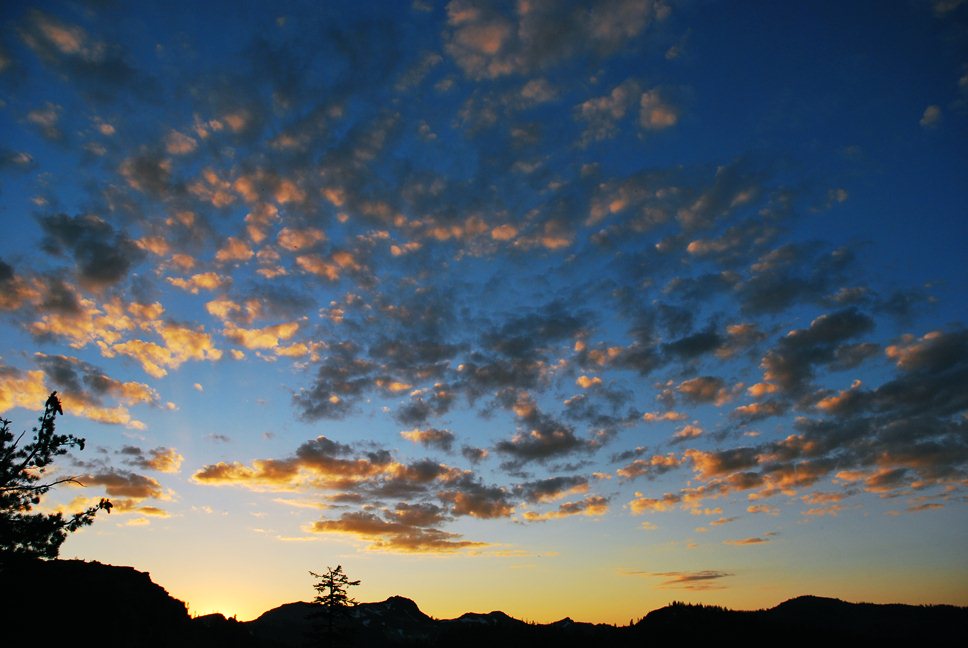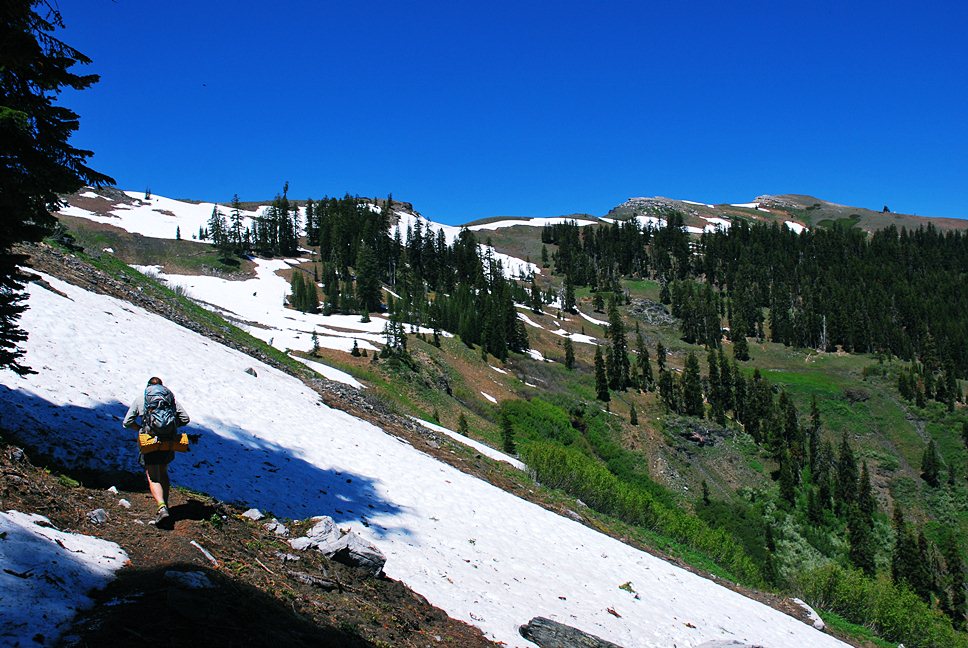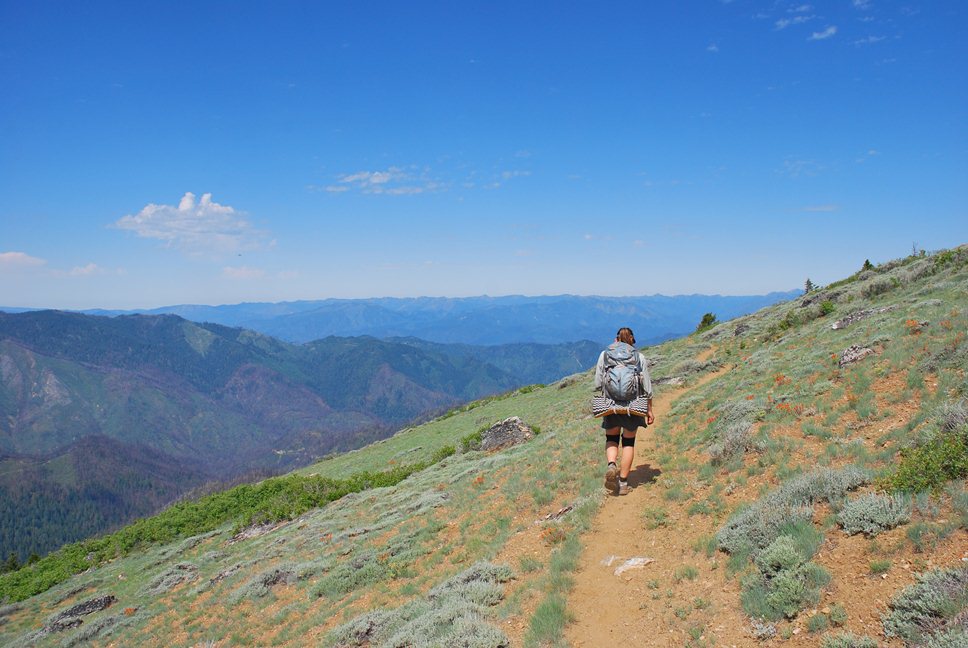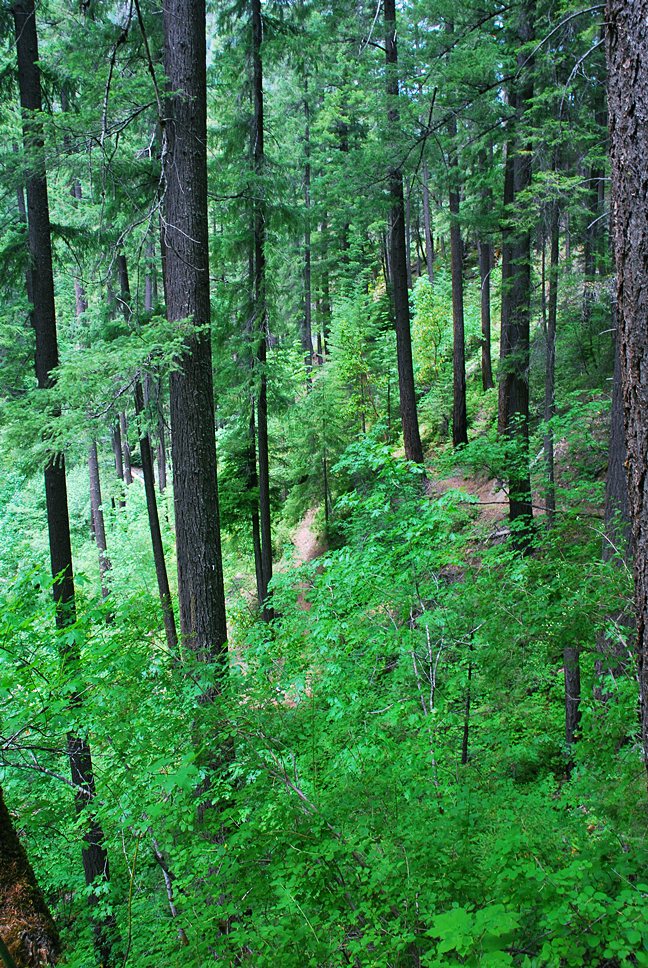Section Q: The PCT in the Marble Mountain Wilderness
July 5-9, 2010
July 5, 2010
Only a kid before Christmas can understand the joy of fulfilled anticipation that I felt as I jumped out of the car and
into the bright, warm sunshine of a California summer. And anyone who has hiked the PCT, I suppose, might also understand. Or anyone who has done anything worthwhile and then has the opportunity to revisit the scene of the accomplishment. Only it was even better than that. I was getting to hike one of the best short stretches of the PCT with another thruhiker who understood exactly what I was thinking and feeling. And I her.

When I hiked in 2003 the Marble Mountain Wilderness was one of the best sections of a trail that shows off stunning beauty every day. Every hour. Almost every minute. Yes, nearly every minute of my hike was an exercise in the display of natural beauty. How can some one be expected
to return to a cube or a factory or life of settled boredom after that? Shauna had hiked in 2008 and had experienced a radically
different kind of trail, but one still abounding in beauty. As we hiked down the trail at the start of our trip together, I thought about nothing. Not a question of philosophy or a meaning for life. I was not searching for anything. I was already home.

An hour passed. Two. When we were tired, we rested. Snow came onto the trail. Heavy, deep, and slightly dangerous snow. It didn't matter. We passed it and kept going to the next ridge. As the sun dipped, we found a indented patch of earth off the trail and spread out our sleeping bags. The smell of pine duff, warmed by the sun, perfumed our bedroom for the night. The stars came out after dinner and there was nothing else that we wanted, nowhere else we'd rather have been. That was how the PCT was for me. All the time, with only two or three exceptions. Only now I had someone from the outside world who understood and who I had to share this with. It was going to be a worthwhile few days.
Oh, the joy. The sun was shining and it was warm. The ridge we were traversing was sharp and our bellies full and Mount Shasta was crystal in the distance. In 2008 Shauna was forced off the PCT at Etna Summit due to fires in the area and had to take a bus around this particular section. The fires had been bad enough that she had not been able to see Shasta until she was in to Oregon.

The winter had featured a huge snow pack in California due to a strong El Nino event, and fierce spring storms built a similar amount in Washington, causing problems for thruhikers who let themselves be worried by things outside of their control. Rather than simply pushing forward, many were hopping around California, Oregon, and Washington searching for an ellusive bit of easy, snow free trail. One of the great treasures that I carried back to Indiana with me after completing the trail was letting go of those things in life that I could not control.

Shauna made me take this picture. I knew the name of this plant when I did, but can't now.

She also made me take this picture. And I also can't remember the name of this one either.

With the amount of snow and water that California had experienced, the wildflower season this early in the summer was spectacular. And Shauna seemed to know almost all the names, or at least the families, and forced me to slow down to look at and appreciate them. From large to small, each had something to offer. Each was unique within it's species. Each had something that made it interesting. But one member was largely the same as another one. For all their beauty, each was, more or less, the same as the other. Diversity within the species was not great. Diversity in the Land was exquisite.

We stopped at Fisher Lake, only recently thawed from the grip of winter, and settled in for lunch with a large collection of salamanders. In the warm sun, Shauna stripped to her backcountry bathing suit and dove into the frigid waters with a yell. I was not tough enough to try the same. I settled for some cheese and ham. An hour passed. We lingered on the warm rock, not needing to push on for the longer miles that thruhikers must commit to doing. With ease and leisure we eventually left the lake and started through the snowy section that we had seen from afar.

An hour of effort passed as we traversed and climbed the snow, with only a few sections of clear trail telling us that
we were still on the right track. But then even these left us as we ascended toward a pass. Two passes. Although we looked at our map, we could not decide if the left or the right pass was correct. And so we took the easier route, which is fine advice to follow in the general world as well. Life is hard enough on its own. No reason to intentionally make it more difficult. We climbed high to the pass, hitting open ground only on top. My heart sank when we got to the top.

Only more snow greeted us on the other side, but snow far steeper and worse looking that what we had traversed before. It was steep enough that at home we would have protected via a running below with pickets and a rope. But we didn't have a rope or pickets or harnesses. Or even ice axes or trekking poles. The snow was hard and steep (approximately 50 degrees; and yes, I do know how to estimate a slope). And down the slope were trees, though too far to be of any use other than to break limbs in case of a fall. Looking at the map we figured out that we were on the wrong pass. After discussing our options, we decided to travsere the slope, for we could see where the trail underneath the snow had to intersect the PCT. Shauna led out slowly, kicking steps as best she could in her trail runners. Fifteen feet out, I heard a noise and looked up to see Shauna slip. And then speed down the icy slope, heading directly for the trees. I could do nothing as I saw her accelerate and approach the trees. At the last second she turned slightly sideways and rocketed between two trees that could not have been more than 3 feet apart. She was out of site. I waited a moment and then yelled. I saw her head, and then the rest of her stand up. She was shaken, but ok. I continued the traverse. Two and a half hours later we emerged on to the PCT and dry ground once again. It had been one of the more dangerous 150 minutes of either of our lives and it was only with some measure of luck that neither of us had anything worse than a few scratches, though later it would turn out that Shauna had torn a rotator cuff during her self arrest of the slide after passing between the two trees and hitting softer snow.

We met three section hikers heading south and after chatting for a while were able to use their tracks along another long section of snow covered PCT. After breaking out of the snow on an open ridge, we found a gorgeous campsite perched on a slight col between two peaks. It didn't take long to set up our room with a view.

Neither of us had brought a book. Neither of us had playing cards. We had no wine. We had no way to kill time, and so we shared time. The sun dipped and we watched the sun set. We were together and we were as one. It was our time under the open sky and the few clouds painted yellow and orange and pink by the atomic fires of our sun, millions of miles away. I can't think of a more perfect night.

There was more snow. But again, it did not matter. This snow was not dangerous, only tiring. We were not going far. Only to a place called Paradise, and it was not far away. The morning was cloudless. Flawless. It was the every morning for me on the PCT. Each day was a mirror of perfection, reflecting the ideal that one hopes for and strives for and is inevitably disappointed in. But not on the PCT, at least not for me.

It isn't a wishful memory remembering something that never happened. A something that one wishes was something else. No. The PCT journal, both my abbreviated notes that I took and in the longer write up that I did after the trail in snowy Indiana, both of these serve as a reminder of how things can be given the right place, the right time, and, most importantly, the right mind. The Zen people call this Beginner's Mind. That is for them to explain. But that is what it is. With it, all things are not only possible, but also perfect.

We cruised down to Paradise, an aptly named lake at the base of a steep rock wall. Packs dropped. Clothing off. Into the lake for a swim in the bracing water and then some time looking at the sky together under the sun, letting our skin dry in the slowest, most pleasurable way possible. It was only the early afternoon. But we were not going anywhere. There was no boredom.

Up we went, up into the sun. Onto a ridge mostly barren of trees, but not lacking in the 360 degree views that we had gotten used to. Shauna had fashioned a sling out of a bandana to support her aching shoulder, though I suspect that much of the pain was forgotten during the high traverse. The last traverse of the trail. For once the ridge ended, the trail would lose nearly a vertical mile in elevation as it plunged to the Klammath river and Seiad Valley.

The PCT runs mostly north-south and well away from the coast. As such, it usually crosses the major rivers of the West near their headwaters in the mountains. But as it nears Mount Shasta it makes a dramatic swing to the West and has to cross the Klammath as it nears the coast, well out of the mountains. PCT hikers have to descend a vertical mile, cross it, and then make a similar ascent on the other side.

Due to the elevation changes and the isolation of the land from major population centers, the Klammath area holds one of the most diverse ecosystems in the United States. Not only were the wildflowers impressive, but there were several plant species and animals that were found nowhere else in the world.

It is a land protected by many wilderness areas, but also a land logged by companies and abused, at times, by people. It was the heart of the State of Jefferson which, if it ever comes into being, will be a future home for me.

The descent off the ridge quickly brought us into a dense forest, one that was thick and old, but one that was more comforting that the primeval forests of my adopted home state of Washington. Down, down, went. Down to a perfect, cold, crystal stream next to which we rested and drank our fill. As neared the bottom the head and the humidity spiked and nary a breath of wind came through the forest to cool us. Poison oak flourished around the banks of Grider creek, which we were following out to the Klammath.

But we would not get there and the end of our hike tonight. Our ride back to Etna Summit was not coming until tomorrow morning, and neither of us wanted to spend an evening in the comparative civilization of Seiad Valley. We crossed a final bridge spanning Grider Creek and saw the start of the road to the Klammath. We paused on the bridge, and did not leave it for the rest of the day. The bridge was cool and their was a breeze blowing day the river, cooling us and keeping the mosquitoes at bay. We laid on the bridge and watched the stars come out, some times in silence, at other times in quiet conversation. But always together and in the moment. Another lesson from the PCT.
I could feel Shauna nudging me in the ribs. It was barely lighter than pitch black. The nudging got stronger. Come on. Breakfast. Let's go. A communications error had her thinking it was five miles longer to Seiad Valley than it actually was. We left early and wandered down the road, with no traffic and no people. Only a beautiful stillness. The only companion we had on the walk to the highway was a black bear, the first that Shauna had ever seen. And a pair of nesting raptors, high above the Klammath. Our solitude came to an end with the bridge across the Klammath and the highway to Seiad Valley. Long haul trucks sped by. A pick up driven by a man with a dog and a mohawk stopped to give us a ride. There were no seats. It was a good way to get to Seiad. With the road our trip ended. Our short return to the PCT was over, though it would not be the last for either of us. I would be leaving soon for the Himalaya. But I would be back. We would be back.

Logistics
Section Q of the PCT runs for 65ish miles from Etna Summit in the south to Seiad Valley in the north. There is public transportation between the town of Etna and Seiad Valley, though it does not run every day. You would have to hitch from Etna to Etna Summit, but this should not be difficult. The PCT is well marked and easy to follow, though if there is sufficient snow a map with be extremely necessary. The hike is not difficult and there are only a few climbs of any note, though this does not mean that the trail is flat.





















